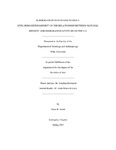Borders from Within and Without: Exploring Heterogeneity between National Identity Type and Immigration Attitudes in the U.S. (thesis)

View/
Author
Smith, Claire Rhodes
Subject
Washington and Lee University -- Honors in Sociology
Emigration and immigration -- Government policy
Emigration and immigration -- Psychological aspects
Nationalism
National characteristics
Metadata
Show full item recordDescription
Thesis; [FULL-TEXT AVAILABLE FOLLOWING A 5-YEAR EMBARGO] Claire Rhodes Smith is a member of the Class of 2021 of Washington and Lee University. Given the strong theoretical linkages connecting national identity and immigration attitudes, social scientists have granted arguably scant focus to empirically examining this relationship. Furthermore, despite the expansive literatures on both national identity and immigration attitudes, each has been operationalized empirically in ways that are theoretically questionable and analytically imprecise. Using 2014 GSS data and drawing upon Bonikowski and DiMaggio's application of latent class analysis to national identity (2016), I employ latent class analysis and factor analysis to study national identity and immigration attitudes, respectively, arguing that these statistical methods reflect our theoretical assumptions with greater precision and clarity. First, my 2014 latent class analysis affirms Bonikowski and DiMaggio's discovery of four distinctive patterns of attitudes toward the nation, types of national identity which vary in their strength of identification with the nation, degree of national pride, and degree of exclusiveness with which they define legitimate national membership. Second, factor analysis of immigration attitudes reveals two latent constructs, which I describe as immigration policy attitudes and perceptions of immigrants and the effects of immigration ("policy" and "perceptions"). Third, I run a series of structural equation models in which policy and perception factor scores are regressed on national identity type net of a series of covariates. I find, most notably, that (a) national identity type is indeed a strong predictor of both policy attitudes and perceptions, (b) despite the refusal of the "creedal" class to define legitimate national membership on the basis of ascribed characteristics, they are willing to exclude on the basis of "civic" characteristics, and (c) there is greater convergence among the national identity classes on perceptions than on policy attitudes. The results suggest both the salience of national identity type as a predictor of immigration attitudes and the importance of clarifying which dimension of immigration attitudes is in question. Claire R. Smith